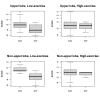Xenobiotic metabolizing enzyme gene polymorphisms predict response to lung volume reduction surgery
- PMID: 17686149
- PMCID: PMC2048957
- DOI: 10.1186/1465-9921-8-59
Xenobiotic metabolizing enzyme gene polymorphisms predict response to lung volume reduction surgery
Abstract
Background: In the National Emphysema Treatment Trial (NETT), marked variability in response to lung volume reduction surgery (LVRS) was observed. We sought to identify genetic differences which may explain some of this variability.
Methods: In 203 subjects from the NETT Genetics Ancillary Study, four outcome measures were used to define response to LVRS at six months: modified BODE index, post-bronchodilator FEV1, maximum work achieved on a cardiopulmonary exercise test, and University of California, San Diego shortness of breath questionnaire. Sixty-four single nucleotide polymorphisms (SNPs) were genotyped in five genes previously shown to be associated with chronic obstructive pulmonary disease susceptibility, exercise capacity, or emphysema distribution.
Results: A SNP upstream from glutathione S-transferase pi (GSTP1; p = 0.003) and a coding SNP in microsomal epoxide hydrolase (EPHX1; p = 0.02) were each associated with change in BODE score. These effects appeared to be strongest in patients in the non-upper lobe predominant, low exercise subgroup. A promoter SNP in EPHX1 was associated with change in BODE score (p = 0.008), with the strongest effects in patients with upper lobe predominant emphysema and low exercise capacity. One additional SNP in GSTP1 and three additional SNPs in EPHX1 were associated (p < 0.05) with additional LVRS outcomes. None of these SNP effects were seen in 166 patients randomized to medical therapy.
Conclusion: Genetic variants in GSTP1 and EPHX1, two genes encoding xenobiotic metabolizing enzymes, were predictive of response to LVRS. These polymorphisms may identify patients most likely to benefit from LVRS.
Figures



Similar articles
-
Association of COPD candidate genes with computed tomography emphysema and airway phenotypes in severe COPD.Eur Respir J. 2011 Jan;37(1):39-43. doi: 10.1183/09031936.00173009. Epub 2010 Jun 4. Eur Respir J. 2011. PMID: 20525719 Free PMC article.
-
Genetic determinants of emphysema distribution in the national emphysema treatment trial.Am J Respir Crit Care Med. 2007 Jul 1;176(1):42-8. doi: 10.1164/rccm.200612-1797OC. Epub 2007 Mar 15. Am J Respir Crit Care Med. 2007. PMID: 17363767 Free PMC article. Clinical Trial.
-
Combined analysis of EPHX1, GSTP1, GSTM1 and GSTT1 gene polymorphisms in relation to chronic obstructive pulmonary disease risk and lung function impairment.Dis Markers. 2011;30(5):253-63. doi: 10.3233/DMA-2011-0782. Dis Markers. 2011. PMID: 21734345 Free PMC article.
-
Is lung volume reduction surgery effective in the treatment of advanced emphysema?Interact Cardiovasc Thorac Surg. 2011 Mar;12(3):480-6. doi: 10.1510/icvts.2010.252213. Epub 2010 Dec 5. Interact Cardiovasc Thorac Surg. 2011. PMID: 21131683 Review.
-
Surgical therapy for chronic obstructive pulmonary disease.Semin Respir Crit Care Med. 2005 Apr;26(2):167-91. doi: 10.1055/s-2005-869537. Semin Respir Crit Care Med. 2005. PMID: 16088435 Review.
Cited by
-
Updates on the COPD gene list.Int J Chron Obstruct Pulmon Dis. 2012;7:607-31. doi: 10.2147/COPD.S35294. Epub 2012 Sep 18. Int J Chron Obstruct Pulmon Dis. 2012. PMID: 23055711 Free PMC article. Review.
-
Cluster analysis in severe emphysema subjects using phenotype and genotype data: an exploratory investigation.Respir Res. 2010 Mar 16;11(1):30. doi: 10.1186/1465-9921-11-30. Respir Res. 2010. PMID: 20233420 Free PMC article.
-
Genetic association analysis of COPD candidate genes with bronchodilator responsiveness.Respir Med. 2009 Apr;103(4):552-7. doi: 10.1016/j.rmed.2008.10.025. Epub 2008 Dec 25. Respir Med. 2009. PMID: 19111454 Free PMC article.
-
Association of COPD candidate genes with computed tomography emphysema and airway phenotypes in severe COPD.Eur Respir J. 2011 Jan;37(1):39-43. doi: 10.1183/09031936.00173009. Epub 2010 Jun 4. Eur Respir J. 2011. PMID: 20525719 Free PMC article.
-
Genetic epidemiology of COPD (COPDGene) study design.COPD. 2010 Feb;7(1):32-43. doi: 10.3109/15412550903499522. COPD. 2010. PMID: 20214461 Free PMC article.
References
-
- Celedon JC, Lange C, Raby BA, Litonjua AA, Palmer LJ, DeMeo DL, Reilly JJ, Kwiatkowski DJ, Chapman HA, Laird N, Sylvia JS, Hernandez M, Speizer FE, Weiss ST, Silverman EK. The transforming growth factor-{beta}1 (TGFB1) gene is associated with chronic obstructive pulmonary disease (COPD) Hum Mol Genet. 2004;13:1649–1656. doi: 10.1093/hmg/ddh171. - DOI - PubMed
-
- Demeo DL, Mariani TJ, Lange C, Srisuma S, Litonjua AA, Celedon JC, Lake SL, Reilly JJ, Chapman HA, Mecham BH, Haley KJ, Sylvia JS, Sparrow D, Spira AE, Beane J, Pinto-Plata V, Speizer FE, Shapiro SD, Weiss ST, Silverman EK. The SERPINE2 Gene Is Associated with Chronic Obstructive Pulmonary Disease. Am J Hum Genet. 2006;78:253–264. doi: 10.1086/499828. - DOI - PMC - PubMed
-
- Hersh CP, Demeo DL, Lange C, Litonjua AA, Reilly JJ, Kwiatkowski D, Laird N, Sylvia JS, Sparrow D, Speizer FE, Weiss ST, Silverman EK. Attempted replication of reported chronic obstructive pulmonary disease candidate gene associations. Am J Respir Cell Mol Biol. 2005;33:71–78. doi: 10.1165/rcmb.2005-0073OC. - DOI - PMC - PubMed
Publication types
MeSH terms
Substances
Grants and funding
- P01 HL083069/HL/NHLBI NIH HHS/United States
- P01HL083069/HL/NHLBI NIH HHS/United States
- HL080242/HL/NHLBI NIH HHS/United States
- R01 HL075478/HL/NHLBI NIH HHS/United States
- HL075478/HL/NHLBI NIH HHS/United States
- N01 HR076119/HL/NHLBI NIH HHS/United States
- N01 HR076118/HL/NHLBI NIH HHS/United States
- N01HR76101/HR/NHLBI NIH HHS/United States
- U01 HL065899/HL/NHLBI NIH HHS/United States
- R01 HL071393/HL/NHLBI NIH HHS/United States
- N01 HR076116/HL/NHLBI NIH HHS/United States
- U01HL065899/HL/NHLBI NIH HHS/United States
- K08 HL080242/HL/NHLBI NIH HHS/United States
- HL71393/HL/NHLBI NIH HHS/United States
LinkOut - more resources
Full Text Sources
Medical
Research Materials
Miscellaneous

